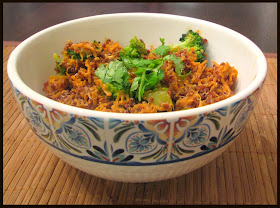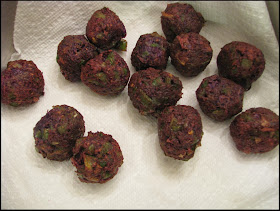The most fun lab (yet) in an online course I'm taking has to be this one - baking molten chocolate cake! I tried an eggless version and it turned out pretty well! The cake was not as chocolately as some other cakes I've baked, but this was still a nice treat. The specialty of this cake is its warm gooey molten chocolatey center! The perfect chocolate dessert in this horrible arctic winter. So, the most important variable in baking this cake is the temperature and time. Keeping temperature at a constant 350 F, it takes just a few minutes before the cake turns from molten-in-the-center to fully baked. Even if you miss the molten center, not to worry. You still end up with a perfectly baked chocolate cake!
Ingredients:
Preparation:
Mix dry ingredients together. Gently mix in all wet ingredients except vinegar. Add vinegar, stir a few times, then pour into eight 2" inch wide oiled ramekins (up to 2/3rd full) or a 9 inch buttered baking pan. Or you can use a cupcake pan. Bake at 350 F for 12 minutes if baking in ramekins, and about 10-11 minutes if using a cupcake pan. I am guessing it will take about 14-15 minutes or slightly longer when baked in a cake pan. The center will be molten when you dig into the cake, but the top will look baked, especially the sides of the cake.
Enjoy!
 |
| The experiment to figure out when the center gets molten and the sides are baked; extreme left: cake is uncooked; extreme right and front: cake is completely cooked. |
- 3/4 cup all-purpose flour
- 3/4 cup white sugar
- 3 tablespoons unsweetened cocoa powder
- 1 teaspoon baking soda
- 1/4 teaspoon salt
- 1/2 cup vegetable oil
- 1 teaspoon vinegar
- 1 teaspoon baking powder
- 1 teaspoon instant coffee powder. The coffee intensifies the chocolate flavor
- 1 cup water
Preparation:
Mix dry ingredients together. Gently mix in all wet ingredients except vinegar. Add vinegar, stir a few times, then pour into eight 2" inch wide oiled ramekins (up to 2/3rd full) or a 9 inch buttered baking pan. Or you can use a cupcake pan. Bake at 350 F for 12 minutes if baking in ramekins, and about 10-11 minutes if using a cupcake pan. I am guessing it will take about 14-15 minutes or slightly longer when baked in a cake pan. The center will be molten when you dig into the cake, but the top will look baked, especially the sides of the cake.
Enjoy!





































